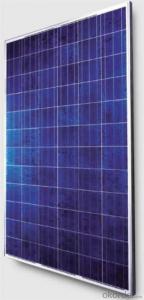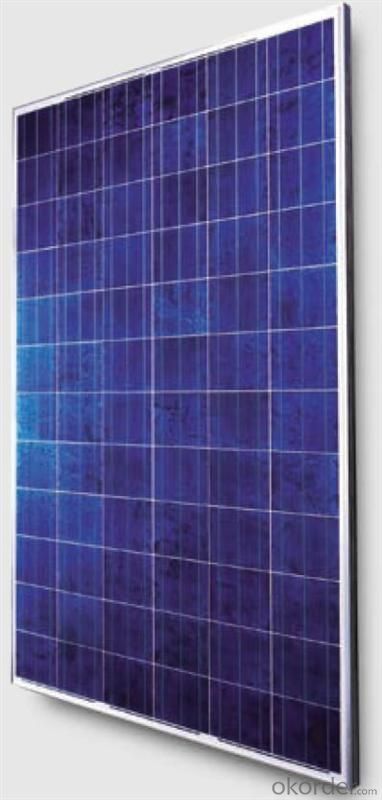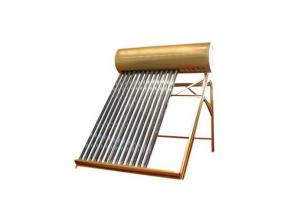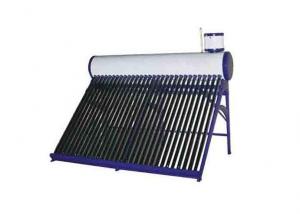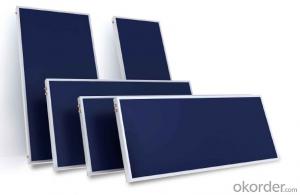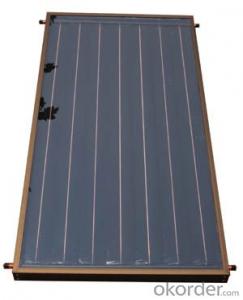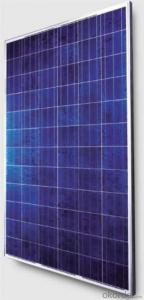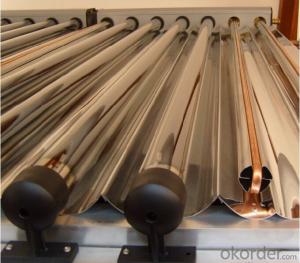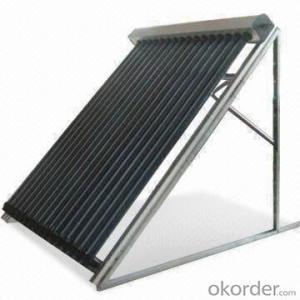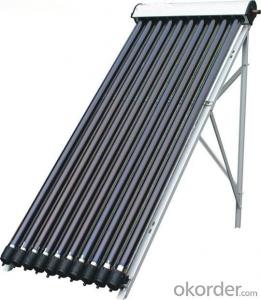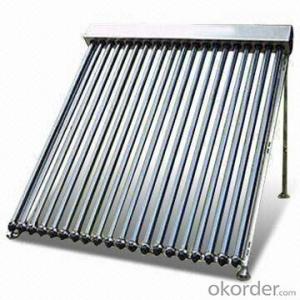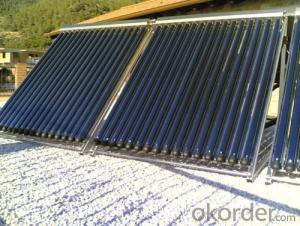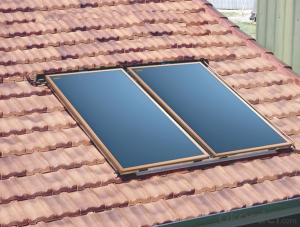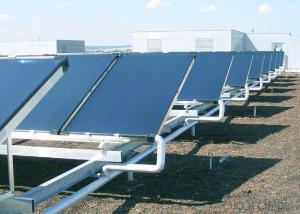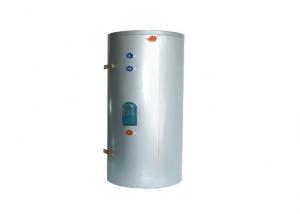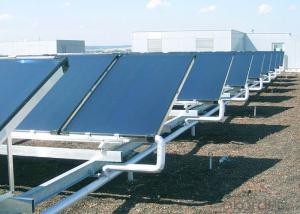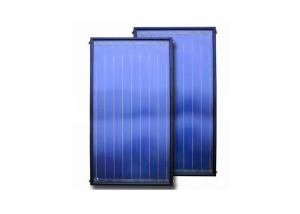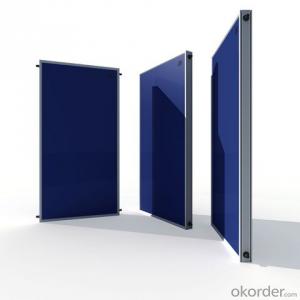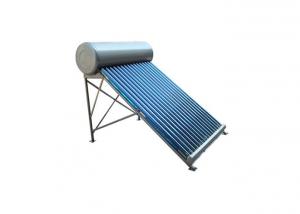Thermomax Evacuated Tube Solar Collectors Integrated with Solar Photovoltaic Polycrystalline Modules
- Loading Port:
- Tianjin
- Payment Terms:
- TT OR LC
- Min Order Qty:
- 1 pallet
- Supply Capability:
- 100000000 pallet/month
OKorder Service Pledge
OKorder Financial Service
You Might Also Like
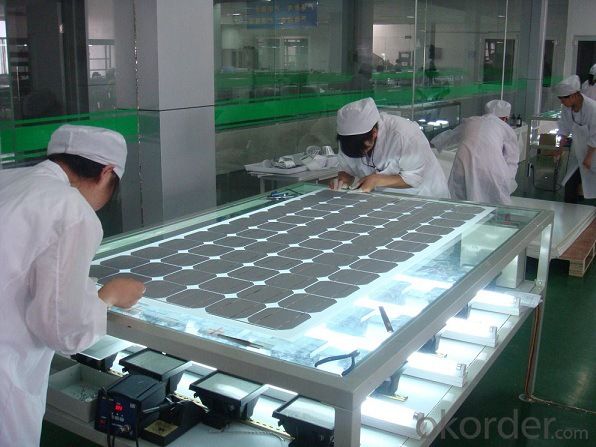
Solar panel refers either to a photovoltaic (PV) module, a solar hot water panel, or to a set of solar photovoltaic modules electrically connected and mounted on a supporting structure. A PV module is a packaged, connected assembly of solar cells. Solar panels can be used as a component of a larger photovoltaic system to generate and supply electricity in commercial and residential applications. Each module is rated by its DC output power under standard test conditions, and typically ranges from 100 to 320 watts. The efficiency of a module determines the area of a module given the same rated output – an 8% efficient 230 watt module will have twice the area of a 16% efficient 230 watt module. There are a few solar panels available that are exceeding 19% efficiency. A single solar module can produce only a limited amount of power; most installations contain multiple modules. A photovoltaic system typically includes a panel or an array of solar modules, an inverter, and sometimes a battery and/or solar tracker and interconnection wiring.
Specifications:
solar panels from 5W--300W, made of TAIWAN MOTECH brand cells,with CO in TAIWAN,Mono and Poly with VDE,IEC,CSA,UL,CE,ISO.
We import solar cells from Taiwan Motech brand, with this CO in taiwan and our CSA certification,we can still sell goods to Anti-dumping areas like USA. Our main products are solar panels, off grid and on grid solar home systems , solar street lighting systems, solar water heating system,solar pump,solar attic fan, solar DC LED lights and solar DC refrigerators.
Certificates : ISO, CE, VDE IEC, MCS, CSA-UL, CEC.
Delivery time: sample 10days, order 25-30days.
Sample: charged.
Payment term: T/T 30% as deposit, 70% before shipment. Or irrevocable L/C at sight.
Trade term: FOB Shenzhen or CIF destination seaport or Airport.
Characteristics:
I.Solar Cell : High efficiency crystalline solar cell. Even if under the weak light, the solar module can produce maximum power output.
II.Tempered glass (toughened glass): Anti-reflecting coating and high transmission rate glass increase the power output and mechanical strength of solar module.
III.EVA and TPT: Using high quality EVA and TPT to prevent destroying and water.
IV.AI frame: Without screw, corner connection. 6 holes on the frame can be installed easily.
V.Junction box: Multi function junction box with water proof.
VI.Long lifetime: ≥25 years; Less power decrease.
VII.Good performance of preventing from atrocious weather such as wind and hails.
VIII.Resisting moisture and etching effectively, not effected by geology.
IX.The certificate issued by international authority: UL, TUV, IEC, VDE, CE.
Quality and Safety
1. Rigorous quality control meets the highest international standards.
2. High-transmissivity low-iron tempered glass, strong aluminium frame.
3. Using UV-resistant silicon.
4. IS09001/14001/CE/TUV/UL
Warranties
1. 10 years limited product warranty
2. 15 years at 90% of the minimal rated power output
3. 25 years at 80% of the minimal rated power output
Technical date :
ITEM NO.: | Poly 156*156 cell ,60pcs . Power range from 230Wp-260Wp | ||||||
Maximum Power(W) | 230 | 235 | 240 | 245 | 250 | 255 | 260 |
Optimum Power Voltage(Vmp) | 29.4 | 29.5 | 29.7 | 30.1 | 30.3 | 30.5 | 30.7 |
Optimum Operatige Current(Imp) | 7.83 | 7.97 | 8.08 | 8.14 | 8.25 | 8.37 | 8.48 |
Open Circuit Voltage(Voc) | 36.7 | 36.8 | 36.9 | 37.1 | 37.3 | 37.5 | 37.7 |
Short Circuit Current(Isc) | 8.52 | 8.59 | 8.62 | 8.65 | 8.69 | 8.73 | 8.78 |
Solar Cell: | 156*156 Poly | ||||||
Number of Cell(pcs) | 6*10 | ||||||
Name of Solar Cells | Polycrystalline Cell | ||||||
Size of Module(mm) | 1650*992*40/45/50 | ||||||
Cable & Connector Type | Pass the TUV Certificate | ||||||
Frame(Material Corners,etc.) | Aluminium-alloy | ||||||
Back sheet | TPT | ||||||
Weight Per Piece(KG) | 19.5KG | ||||||
FF (%) | 70-76% | ||||||
Junction Box Type | Pass the TUV Certificate | ||||||
Tolerance Wattage(e.g.+/-5%) | ±3%, or 0-3% | ||||||
Front Glass Thickness(mm) | 3.2 | ||||||
Temperature Coefficients of Isc(%) | +0.04 | ||||||
Temperature Coefficients of Voc(%) | -0.38 | ||||||
Temperature Coefficients of Pm(%) | -0.47 | ||||||
Temperature Coefficients of Im(%) | +0.04 | ||||||
Temperature Coefficients of Vm(%) | -0.38 | ||||||
Temperature Range | -40°C to +85°C | ||||||
Surface Maximum Load Capacity | 5400Pa | ||||||
Allowable Hail Load | 23m/s ,7.53g | ||||||
Bypass Diode Rating(A) | 12 | ||||||
Warranty | 90% of 10 years, 80% of 25 years. | ||||||
Standard Test Conditions | AM1.5 1000W/ 25 +/-2°C | ||||||
Packing | carton or pallet | ||||||
1*20' | 14 Pallets / 316pcs | ||||||
1*40'STD | 25 Pallets / 700pcs | ||||||
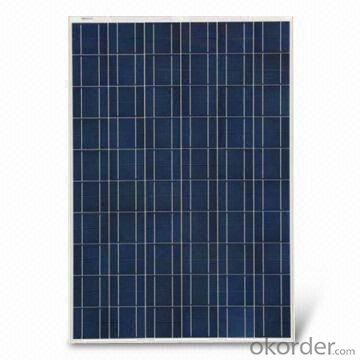
FAQ:
We have organized several common questions for our clients,may help you sincerely:
1. What’s price per watt?
A: It’s depends on the quantity, delivery date and payment terms of the order. We can talk further about the detail price issue. Our products is high quality with lower price level.
2. Can you tell me the parameter of your solar panels?
We have different series of cells with different power output, both from c-si to a-si. Please take our specification sheet for your reference.
3. How do you pack your products?
We have rich experience on how to pack the panels to make sure the safety on shipment when it arrives at the destination.
4. Can you do OEM for us?
Yes, we can.
5. How long can we receive the product after purchase?
In the purchase of product within three working days, We will arrange the factory delivery as soon as possible. The perfect time of receiving is related to the state and position of customers. Commonly 7 to 10 working days can be served.
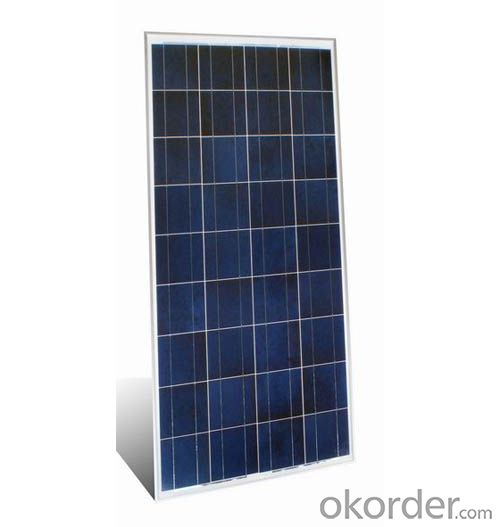
- Q: How much electricity can a solar collector generate?
- The amount of electricity that a solar collector can generate depends on various factors such as the size and efficiency of the collector, the amount of sunlight available, and the location of the collector. On average, a solar collector can generate anywhere from a few hundred watts to several kilowatts of electricity.
- Q: Can solar collectors be used in solar thermal biomass gasification?
- Yes, solar collectors can be used in solar thermal biomass gasification. Solar thermal biomass gasification is a process that converts biomass into a combustible gas called syngas, which can be used as a fuel for various applications. Solar collectors can be used to harness the sun's energy and provide the heat required for the gasification process. The solar collectors capture sunlight and convert it into thermal energy, which can then be used to heat the biomass and initiate the gasification reaction. By using solar collectors, the reliance on traditional fossil fuels for the heat source in biomass gasification can be reduced, leading to a more sustainable and environmentally friendly process. Additionally, integrating solar collectors with biomass gasification can increase the overall efficiency of the system and improve its energy sustainability.
- Q: Can solar collectors be used to generate electricity during nighttime hours?
- No, solar collectors cannot be used to generate electricity during nighttime hours. Solar collectors rely on sunlight to generate electricity, as they convert sunlight into usable energy. At night, when the sun is not shining, there is no source of sunlight available for the solar collectors to generate electricity. However, there are alternative methods to generate electricity during nighttime hours, such as using batteries to store excess solar energy generated during the day for later use.
- Q: Can solar collectors be used for heating water in homes?
- Solar collectors have the capability to heat water in homes. In order to achieve this, solar water heating systems employ solar collectors, also known as solar thermal panels or solar water heaters. These collectors are typically placed on rooftops or in open areas where they can receive optimum sunlight exposure. Within these collectors, there are tubes through which a heat transfer fluid, such as water or antifreeze, circulates. When the sun's rays make contact with the collectors, the fluid contained within absorbs the heat and subsequently transfers it to a storage tank or directly to the home's water supply. This heated water can then be utilized for various household purposes, including bathing, dishwashing, and laundry. Solar water heating systems are not only eco-friendly, but also a cost-effective alternative to conventional water heating methods, as they diminish the dependence on fossil fuels and can substantially reduce energy bills.
- Q: Can solar collectors be used for heating in tropical regions?
- Yes, solar collectors can indeed be used for heating in tropical regions. Despite the abundance of sunlight in these regions, solar collectors can still effectively harness solar energy to provide heating for various purposes such as water heating, space heating, or even air conditioning. The use of solar collectors in tropical regions can contribute to energy efficiency, reduce reliance on fossil fuels, and lower greenhouse gas emissions.
- Q: Can solar collectors be used for heating power plants?
- Yes, solar collectors can be used for heating power plants. Solar thermal power plants utilize solar collectors to capture and harness the sun's energy to generate heat, which is then used to produce steam to drive turbines and generate electricity. This technology, known as concentrated solar power (CSP), is an effective and sustainable method for heating power plants while reducing reliance on fossil fuels.
- Q: How long does it take for a solar collector system to pay for itself?
- The payback period for a solar collector system can vary based on several factors including the initial cost, energy savings, and local incentives. On average, it takes around 5 to 10 years for a solar collector system to pay for itself through reduced energy bills.
- Q: Can solar collectors be used in areas with limited water supply?
- Yes, solar collectors can be used in areas with limited water supply. Unlike other forms of renewable energy, solar collectors do not require water to generate electricity or heat. They work by converting sunlight into usable energy, making them suitable for use in arid regions or places with limited access to water resources. Solar collectors are a sustainable and efficient solution for generating power without putting additional strain on water supplies.
- Q: Can solar collectors be used in combination with heat pumps?
- Yes, solar collectors can be used in combination with heat pumps. This combination is often referred to as a solar thermal heat pump system. In this setup, solar collectors are used to capture thermal energy from the sun and transfer it to a heat pump. The heat pump then amplifies the captured heat and transfers it to a space heating or water heating system. By combining solar collectors with heat pumps, the system becomes more efficient and sustainable. The solar collectors provide an initial source of renewable energy, reducing the reliance on fossil fuels. The heat pump amplifies and enhances this energy, maximizing the overall efficiency of the system. This combination is particularly beneficial in areas with varying weather conditions. During sunny days, the solar collectors can provide a significant amount of thermal energy, reducing the load on the heat pump. On cloudy or less sunny days, the heat pump can compensate for the lower solar input by using its own energy efficiency to maintain the desired temperature. Furthermore, the integration of solar collectors with heat pumps can also provide benefits in terms of cost savings. The solar energy captured by the collectors can offset the electricity consumption of the heat pump, leading to reduced energy bills. In summary, using solar collectors in combination with heat pumps is a viable and effective solution for harnessing renewable energy and providing efficient heating and hot water systems. This combination offers both environmental and economic benefits, making it an attractive option for homeowners and businesses alike.
- Q: What is the effect of high winds on solar collectors?
- High winds can have a negative impact on solar collectors. They can cause the collectors to vibrate or shake, potentially damaging their structural integrity. Additionally, strong winds can blow dust and debris onto the collectors, reducing their efficiency by blocking sunlight. Therefore, it is important to consider the wind resistance and stability of solar collectors when installing them to ensure optimal performance and longevity.
Send your message to us
Thermomax Evacuated Tube Solar Collectors Integrated with Solar Photovoltaic Polycrystalline Modules
- Loading Port:
- Tianjin
- Payment Terms:
- TT OR LC
- Min Order Qty:
- 1 pallet
- Supply Capability:
- 100000000 pallet/month
OKorder Service Pledge
OKorder Financial Service
Similar products
Hot products
Hot Searches
Related keywords
